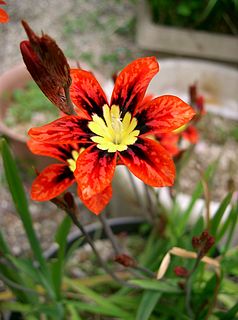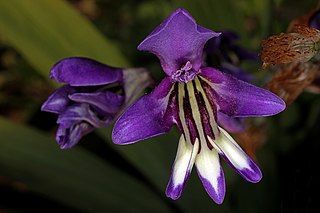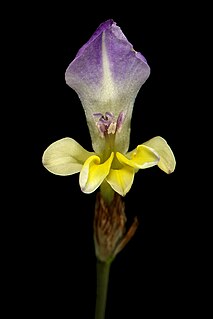
Caenorhabditis elegans is a free-living transparent nematode about 1 mm in length that lives in temperate soil environments. It is the type species of its genus. The name is a blend of the Greek caeno- (recent), rhabditis (rod-like) and Latin elegans (elegant). In 1900, Maupas initially named it Rhabditides elegans. Osche placed it in the subgenus Caenorhabditis in 1952, and in 1955, Dougherty raised Caenorhabditis to the status of genus.

Sparaxis tricolor, known by the common names wandflower, harlequin flower, and sparaxis, is a bulb-forming perennial plant that grows in well-drained sunny soil. It gained its name from its colorful flowers which are bi- or tri-coloured with a golden centre and a small ring of brown surrounded by another colour.

Sparaxis is a genus of flowering plants called the harlequin flowers. It belongs to the iris family Iridaceae with about 13 species endemic to Cape Province, South Africa.

Iridaceae is a family of plants in order Asparagales, taking its name from the irises, meaning rainbow, referring to its many colours. There are 66 accepted genera with a total of c. 2244 species worldwide. It includes a number of other well known cultivated plants, such as freesias, gladioli and crocuses.

The blue-tailed damselfly or common bluetail is a damselfly, belonging to the family Coenagrionidae.

Banksia elegans, commonly known as the elegant banksia, is a species of woody shrub that is endemic to a relatively small area of Western Australia. Reaching 4 m (13 ft) high, it is a suckering shrub that rarely reproduces by seed. The round to oval yellow flower spikes appear in spring and summer. Swiss botanist Carl Meissner described Banksia elegans in 1856. It is most closely related to the three species in the subgenus Isostylis.

Ctenochasma is a genus of Late Jurassic ctenochasmatid pterosaur belonging to the suborder Pterodactyloidea. Three species are currently recognized: C. roemeri, C. taqueti, and C. elegans. Their fossilized remains have been found in the Solnhofen Limestone of Bavaria, Germany, the "Purbeck Group" of northeastern Germany, and the Calcaires tâchetés of eastern France.

The Nubian flapshell turtle or Nubian soft-shelled turtle is one of two species of softshell turtle in the genus Cyclanorbis of the Trionychidae family. It has historically been found in a wide range spanning Benin, Central African Republic, Chad, Ethiopia, Ghana, Nigeria, Sudan, and Togo. However, it has been very rarely recorded during the last 50 years and there is little hope that the species is extant in Ghana, Benin, Togo, Nigeria and Cameroon. In early 2019, a remnant population was found in the White Nile wetlands in South Sudan by Prof. Luca Luiselli and his team.

Eudromia is a genus of birds in the tinamou family. This genus comprises two crested members of this South American family.

The false ark shells (Cucullaea) are a small genus of marine bivalve molluscs related to the ark clams. The genus is the only member of the family Cucullaeidae.

Crocoideae is one of the major subfamilies in the family Iridaceae.

Sparaxis bulbifera, commonly known as harlequin flower, is a bulb-forming perennial plant. The species is native to Cape Province in South Africa and naturalised in the Azores and Australia. It grows to between 15 and 60 cm high and has white to cream flowers.
In molecular biology mir-84 microRNA is a short RNA molecule. MicroRNAs function to regulate the expression levels of other genes by several mechanisms.
Prioniodus is an extinct genus of conodonts in the family Balognathidae from the Ordovician.
The Daf-9 gene encodes a cytochrome p450 enzyme catalysis the generation of dafachronic acid in the worm Caenorhabditis elegans, with the CYP Symbol CYP22A1. After generation, dafachronic acid will binding it's nuclear receptor Daf-12 and has been implicated by Cynthia Kenyon and colleagues related to the formation of Dauer larva.

Sparaxis auriculata, is a species of Sparaxis found in West Cape, South Africa.

Sparaxis grandiflora, is a species of Sparaxis found in Western Cape, South Africa.

Sparaxis metelerkampiae, is a species of Sparaxis found in Western Cape, South Africa.

Sparaxis pillansii, is a species of Sparaxis found in Northern Cape, South Africa.

Sparaxis villosa, is a species of Sparaxis found in South Africa.
















